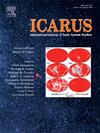Preservation of organic traces of life under Martian conditions: Influence of the nature of the smectite in presence
IF 3
2区 物理与天体物理
Q2 ASTRONOMY & ASTROPHYSICS
引用次数: 0
Abstract
Clay-rich Martian rocks are considered promising targets in the search for fossilized remains of ancient Martian life. However, the actual influence of the clay mineral compositions in preserving microbial biosignatures remains poorly understood. Here, we explore the biopreservation potential of three pure smectites typically found on Mars and containing Al in their tetrahedral sheets (i.e. a Mg-rich, a Fe-rich and a Al-rich smectite), relying on experiments run using E. coli as a biological analog to simulate hydrothermal alteration scenarios relevant to Mars. The results show that Mg-rich smectites (saponite) are more effective at preserving biomolecules from thermal degradation than Fe-rich and Al-rich smectites (nontronite and beidellite). Plus, in contrast to saponite, neither nontronite nor beidellite appears to significantly trap (and thus preserve) organic compounds within their interlayer spaces. Overall, the present study highlights that both the chemistry and the abundance of organic material in ancient Martian clay-rich rocks will depend on the compositional nature of smectites initially present.
火星条件下有机生命痕迹的保存:存在的蒙脱石性质的影响
富含粘土的火星岩石被认为是寻找古代火星生命化石遗骸的有希望的目标。然而,粘土矿物组成对保存微生物生物特征的实际影响仍然知之甚少。在这里,我们探索了通常在火星上发现的三种纯蒙脱石的生物保存潜力,并在其四面体薄片中含有Al(即富mg,富fe和富Al蒙脱石),依靠大肠杆菌作为生物模拟物来模拟与火星相关的热液蚀变情景。结果表明,富镁蒙脱石(皂石)比富铁和富铝蒙脱石(非脱石和贝德尔石)更有效地保护生物分子免受热降解。此外,与皂土相比,非膨润土和贝德尔石似乎都没有明显地在层间空间中捕获(并因此保存)有机化合物。总的来说,目前的研究强调,在古代火星富含粘土的岩石中,化学成分和有机物质的丰度将取决于最初存在的蒙脱石的组成性质。
本文章由计算机程序翻译,如有差异,请以英文原文为准。
求助全文
约1分钟内获得全文
求助全文
来源期刊

Icarus
地学天文-天文与天体物理
CiteScore
6.30
自引率
18.80%
发文量
356
审稿时长
2-4 weeks
期刊介绍:
Icarus is devoted to the publication of original contributions in the field of Solar System studies. Manuscripts reporting the results of new research - observational, experimental, or theoretical - concerning the astronomy, geology, meteorology, physics, chemistry, biology, and other scientific aspects of our Solar System or extrasolar systems are welcome. The journal generally does not publish papers devoted exclusively to the Sun, the Earth, celestial mechanics, meteoritics, or astrophysics. Icarus does not publish papers that provide "improved" versions of Bode''s law, or other numerical relations, without a sound physical basis. Icarus does not publish meeting announcements or general notices. Reviews, historical papers, and manuscripts describing spacecraft instrumentation may be considered, but only with prior approval of the editor. An entire issue of the journal is occasionally devoted to a single subject, usually arising from a conference on the same topic. The language of publication is English. American or British usage is accepted, but not a mixture of these.
 求助内容:
求助内容: 应助结果提醒方式:
应助结果提醒方式:


